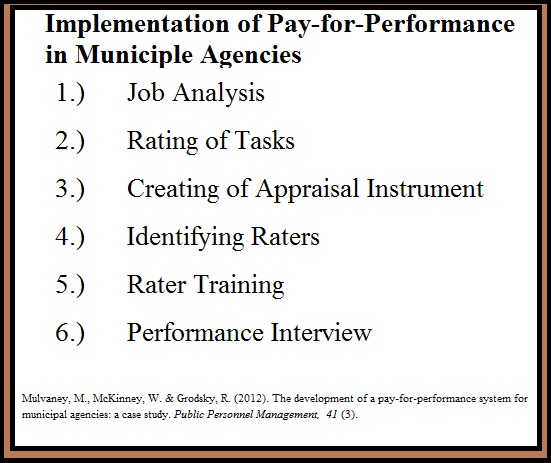Governmental agencies are
often seen as ineffective in managing the human capital within their
departments. As budgets become strained and tax revenue declines officials will
need to find new ways of motivating and managing employees to do more with
less. The development of higher employee engagement and performance often
starts with the performance appraisal and the standards set within. The use of
pay-for-performance can increase both the skill and standards within such
agencies.
Human resource functions
often set the pay and performance criteria of public service employees. In
public agencies the cost of labor can be heavy and accounts for approximately
60% of municipal budgets (Chelladurai, 1999). The effective management of taxpayer
dollars often rests on the proper utilization of this resource for greater
public service.
To develop stronger uses
of human capital there should to be higher levels of alignment between work
criteria and organizational objectives. An
important factor in creating this alignment rests on tying compensation closely
to organizational service requirements to minimize human capital waste (Dyer
& Reeves, 1995). Employees need to
focus on those tasks which are most important for the function of the
organization.
Pay-per-performance is a
method of compensating employees for the quality of work they complete. In municipal
employees accustomed to universal performance appraisals and minimum
performance standards there isn’t much incentive for higher levels of effort.
Pay-for-performance systems have been described as one of the most effective
methods of motivating and increasing performance (Levy & Williams, 2004).
Research helps open the
door to understanding how environments that may have been opposed to
pay-for-performance in the past may be receptive to such measures if employee
input is considered. By partnering with employees to develop higher standards
the performance system creates higher levels of perceived validity and greater
trust with management. Through employee engagement the organization can realign
employee efforts to save taxpayer dollars.
Research conducted by Mulvaney, McKinney, &
Grodsky (2012) Study of 70 full-time and 550 part-time employees in the
Elmhurst Park District of Illinois help highlight potential new performance
measures for public employees. To implement an effective pay-for-performance
system within municipal government required six important steps:
- 1.) Job Analysis: Systematic method of gathering and analyzing information on the content of jobs.
- 2.) Rating of Tasks: This includes the rating of tasks as to their importance to the success of the organization.
- 3.) Creating of Appraisal Instrument: The development of the appraisal system based upon job tasks.
- 4.) Identifying Raters: People who would be most accurate in assessing performance were selected to conduct the appraisals.
- 5.) Rater Training: Each of the raters was trained to reduce bias and errors.
- 6.) Performance Interview: Seeking and discussing potential information to include in the performance appraisal system.
The results help indicate that improvement in
employee perception are beneficial results of developing employee
pay-for-performance systems in which employees are participants in their
development. The study was considered a pilot study that briefly tries to grasp
the main concepts of transformation in government agencies. Additional research
would be helpful in improving the likelihood of positive outcomes. The findings
are as follows.
-Cognitive and affective value of employees’
engagement in developing pay-for-performance evaluations.
-Additional agreement between management and
employee perceptions of fairness and
accuracy with evaluations.
-Noticeable performance improvement with employees
who received feedback.
-There were higher levels of perceived procedural
trust with the pay-for-performance evaluations.
Chelladurai, P. (1999). Human resource management in sport and recreation. Chicago,
IL.:Human Kinetics
Dyer, L. & Reeves, T. (1995). Human resource
strategies and firm performance: what do we know and where do we need to go? International Journal of Human Resource
Management, 5 (3).
Levy, P. & Williams, J.
(2004). The social context of performance appraisals: a review and framework
for the hitwe. Journal of Management, 20
(6).
Mulvaney, M., McKinney, W. & Grodsky, R. (2012).
The development of a pay-for-performance system for municipal agencies: a case
study. Public Personnel Management, 41 (3).

No comments:
Post a Comment